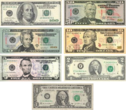US Dollar Weakens Amid Global Economic Volatility
By VOA
Confidence in the U.S. dollar, long the world’s premier currency, has been weakening as a reflection of investor doubts about the shaky American economy and the ability of its government to deal with burgeoning long-term debt.
For years, as economies around the globe teetered, investors looked to the U.S. dollar as a safe-haven investment, with the U.S. the most reliable country in the world to repay its debts. But with Standard & Poor’s downgrading of the U.S. credit rating last week, investors now are looking at other currencies – especially the Japanese yen and the Swiss franc – as possible safer, alternative currencies to hold in a time of world economic uncertainty.
 As a result, the dollar has been losing value in recent days against the yen and the franc, even as the Japanese and Swiss governments worry that their currencies are becoming too valuable, hurting the sale of products from their countries on overseas markets.
As a result, the dollar has been losing value in recent days against the yen and the franc, even as the Japanese and Swiss governments worry that their currencies are becoming too valuable, hurting the sale of products from their countries on overseas markets.
In past financial crises, the dollar has tended to rise in value. Some analysts, like those at Standard & Poor’s, say that concern about the U.S. economy and the recent protracted debate between President Barack Obama and Congress over raising the country’s borrowing limit have left investors wondering about the country’s resolve to correct its habit of borrowing more money to finance its government operations.
China is the world’s second-largest economy behind the U.S., and the American government’s biggest foreign creditor. It has sharply criticized what it says is an American “addiction to debt,” but it and other countries that buy U.S. Treasury bonds may have little choice but to continue to lend money to the U.S. because most other countries sell too little debt or have significantly shakier economies than the U.S.
Some investors are even more worried about governmental debt in European countries – particularly Italy and Spain – fearing they could follow Greece, Ireland and Portugal in needing international financial bailouts.
Over time, the decline in the worth of the U.S. dollar could help decrease the country’s huge international trade deficit, which totals hundreds of billions of dollars annually. But that could be a slow process to reverse the long-term trade deficit. The day-to-day volatility of world economic forces, such as the downgrading of the U.S. credit rating, are likely to be a more potent factor in determining the relative standing of the U.S. dollar.
